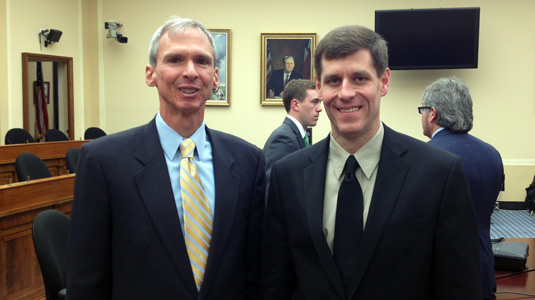Mark Hersam Testifies about Nanotechnology Before Congress
Hersam called for “coordinated, predictable, and sustained federal funding” for research

Last week Mark Hersam testified before U.S. Congress to push for “coordinated, predictable, and sustained federal funding” for nanotechnology research and development. He said that sustained support is particularly needed for fundamental research because of its potential for “unanticipated breakthroughs.”
The U.S. House of Representatives Committee on Science, Space, and Technology’s Subcommittee on Research and Technology examined the current state of nanotechnology research, development, opportunities, and challenges during a hearing titled “Nanotechnology: From Laboratories to Commercial Products.” The event took place on Tuesday, May 20 in Washington, D.C.
Hersam, the Bette and Neison Harris Chair in Teaching Excellence, professor of materials science and engineering, chemistry, and medicine, and director of Northwestern’s Materials Research Center, was among five witnesses at the hearing.
Throughout his career at Northwestern, Hersam’s research has been mainly funded by the National Nanotechnology Initiative, which was announced in 2000. At that time, graphene—the material that is a major focus of his work—was unidentified.
“However, this material was later discovered in 2004, rapidly advanced over the next five years, and ultimately won the Nobel Prize in Physics by the year 2010,” Hersam told the subcommittee.
Hersam said that fundamental research should be fostered by expanding the National Science Foundation Nanoscale Science and Engineering Centers and that applied technology development would be accelerated by supporting the National Science Foundation Nanosystems Engineering Research Centers.
Hersam shared the story of his company NanoIntegris, a supplier of high purity, semiconducting, and metallic inks. Nearly 10 years after filing a patent application, some of the claims for the company’s products remains pending. Hersam asked the subcommittee to improve the efficiency of the United States Patent and Trademark Office in order to protect nanotechnology commercialization.
“While the NanoIntegris story is largely positive,” he said, “its ultimate success was nearly compromised by issues surrounding intellectual property. …The absence of issued patents likely contributed to our technology being blatantly copied by multiple companies in Asia, which created stress on our emerging business that could have been minimized with more expeditious patent protection.”
During his time before the subcommittee, Hersam also recommended the reinstatement of the National Nanotechnology Infrastructure Network, the expansion of support for the Small Business Innovation Research program, and growth of the National Science Foundation and National Defense Science and Engineering Graduate Fellowship programs.
“It is well documented that the United States is trailing many other industrialized nations in science, technology, engineering, and math education at all levels including K-12, undergraduate, and graduate students,” Hersam said. “While this problem is multi-faceted with no easy solution, the situation is certainly improved when the most talented American students are inspired to pursue careers in science and engineering.”